heating BMW ACTIVE HYBRID 3 2015 F30H Owner's Manual
[x] Cancel search | Manufacturer: BMW, Model Year: 2015, Model line: ACTIVE HYBRID 3, Model: BMW ACTIVE HYBRID 3 2015 F30HPages: 251, PDF Size: 5.49 MB
Page 19 of 251
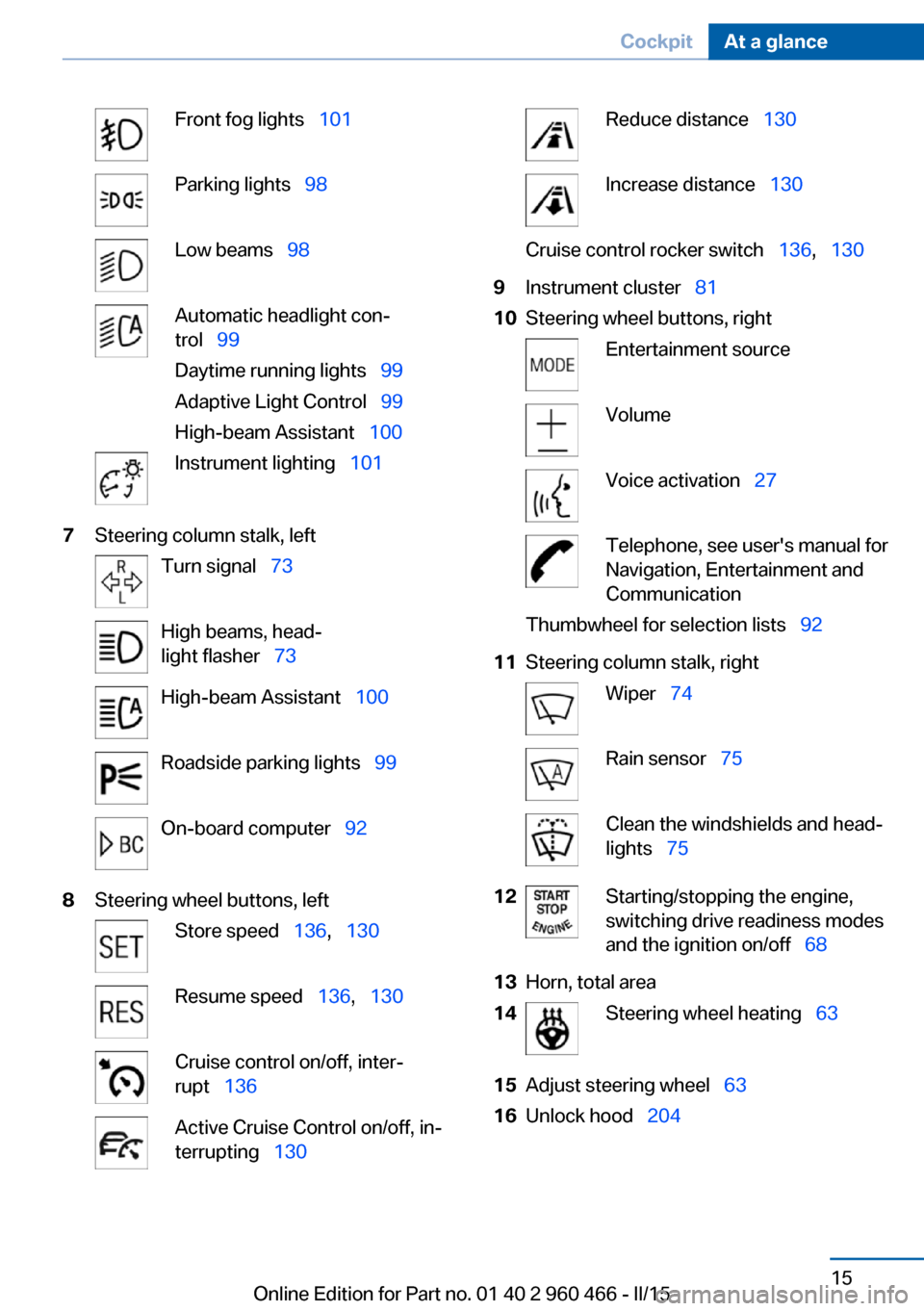
Front fog lights‚Äā‚ÄÖ101Parking lights‚Äā‚ÄÖ98Low beams‚Äā‚ÄÖ98Automatic headlight con‚Äź
trol‚Äā‚ÄÖ 99
Daytime running lights‚Äā‚ÄÖ 99
Adaptive Light Control‚Äā‚ÄÖ 99
High-beam Assistant‚Äā‚ÄÖ 100Instrument lighting‚Äā‚ÄÖ1017Steering column stalk, leftTurn signal‚Äā‚ÄÖ73High beams, head‚Äź
light flasher‚Äā‚ÄÖ 73High-beam Assistant‚Äā‚ÄÖ 100Roadside parking lights‚Äā‚ÄÖ 99On-board computer‚Äā‚ÄÖ928Steering wheel buttons, leftStore speed‚Äā‚ÄÖ136,‚Äā‚ÄÖ130Resume speed‚Äā‚ÄÖ 136,‚Äā‚ÄÖ130Cruise control on/off, inter‚Äź
rupt‚Äā‚ÄÖ 136Active Cruise Control on/off, in‚Äź
terrupting‚Äā‚ÄÖ 130Reduce distance‚Äā‚ÄÖ 130Increase distance‚Äā‚ÄÖ 130Cruise control rocker switch‚Äā‚ÄÖ 136,‚Äā‚ÄÖ1309Instrument cluster‚Äā‚ÄÖ 8110Steering wheel buttons, rightEntertainment sourceVolumeVoice activation‚Äā‚ÄÖ27Telephone, see user's manual for
Navigation, Entertainment and
CommunicationThumbwheel for selection lists‚Äā‚ÄÖ 9211Steering column stalk, rightWiper‚Äā‚ÄÖ74Rain sensor‚Äā‚ÄÖ 75Clean the windshields and head‚Äź
lights‚Äā‚ÄÖ 7512Starting/stopping the engine,
switching drive readiness modes
and the ignition on/off‚Äā‚ÄÖ 6813Horn, total area14Steering wheel heating‚Äā‚ÄÖ 6315Adjust steering wheel‚Äā‚ÄÖ6316Unlock hood‚Äā‚ÄÖ204Seite 15CockpitAt a glance15
Online Edition for Part no. 01 40 2 960 466 - II/15
Page 61 of 251

Front seat heating
Switching onPress button once for each tempera‚Äź
ture level.
The maximum temperature is reached when
three LEDs are lit.
If the journey is continued within approx. 15
minutes, the seat heating is activated automat‚Äź
ically with the temperature selected last.
When ECO PRO, refer to page 181, is acti‚Äź
vated, the heater output is reduced.
Switch off Press button longer.
The LEDs go out.
Rear seat heating
Switching on Press button once for each tempera‚Äź
ture level.
The maximum temperature is reached when
three LEDs are lit.
If the journey is continued within approx. 15
minutes, the seat heating is activated automat‚Äź
ically with the temperature selected last.
When ECO PRO, refer to page 181, is acti‚Äź
vated, the heater output is reduced.
Switch off Press button longer.
The LEDs go out.
Safety belts
Seats with safety belt The vehicle has five seats, each of which is
equipped with a safety belt.
General information
Always make sure that safety belts are being
worn by all occupants before driving off.
For the occupants' safety the belt locking
mechanism triggers early. Slowly guide the
belt out of the holder when applying it.
Although airbags enhance safety by providing
added protection, they are not a substitute for
safety belts.
The upper shoulder strap's anchorage point
will be correct for adult seat occupants of ev‚Äź
ery build if the seat is correctly adjusted.‚Ė∑The two outer safety belt buckles,
integrated into the rear seat, are for pas‚Äź
sengers sitting on the left and right.‚Ė∑The center rear safety belt buckle is solely
intended for the center passenger.
Hints
One person per safety belt
Never allow more than one person to
wear a single safety belt. Never allow infants or
small children to ride on a passenger's lap.‚óÄ
Seite 57AdjustingControls57
Online Edition for Part no. 01 40 2 960 466 - II/15
Page 66 of 251
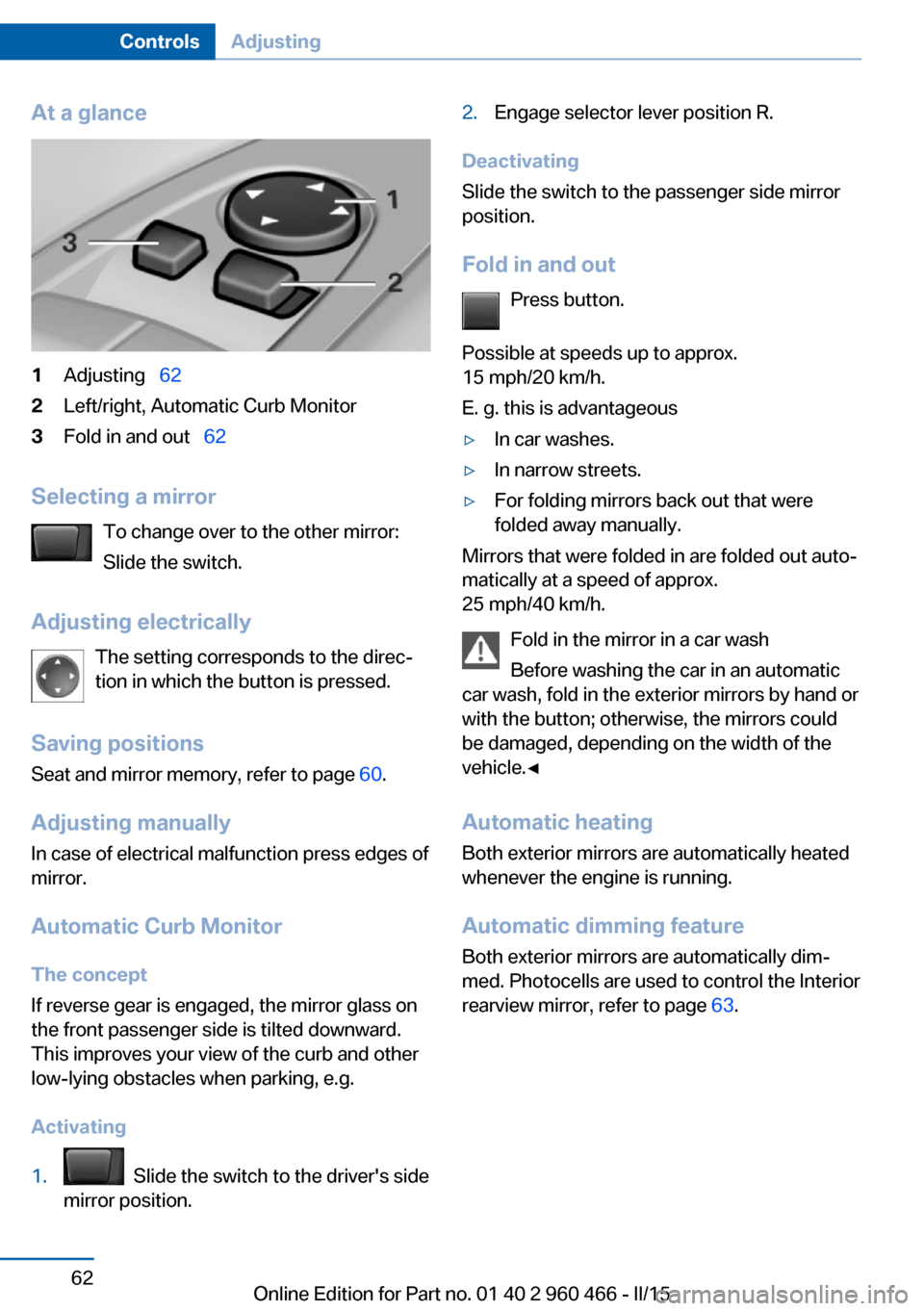
At a glance1Adjusting‚Äā‚ÄÖ622Left/right, Automatic Curb Monitor3Fold in and out‚Äā‚ÄÖ 62
Selecting a mirror
To change over to the other mirror:
Slide the switch.
Adjusting electrically The setting corresponds to the direc‚Äź
tion in which the button is pressed.
Saving positions
Seat and mirror memory, refer to page 60.
Adjusting manually
In case of electrical malfunction press edges of
mirror.
Automatic Curb MonitorThe concept
If reverse gear is engaged, the mirror glass on
the front passenger side is tilted downward.
This improves your view of the curb and other
low-lying obstacles when parking, e.g.
Activating
1. Slide the switch to the driver's side
mirror position.2.Engage selector lever position R.
Deactivating
Slide the switch to the passenger side mirror
position.
Fold in and out Press button.
Possible at speeds up to approx.
15 mph/20 km/h.
E. g. this is advantageous
‚Ė∑In car washes.‚Ė∑In narrow streets.‚Ė∑For folding mirrors back out that were
folded away manually.
Mirrors that were folded in are folded out auto‚Äź
matically at a speed of approx.
25 mph/40 km/h.
Fold in the mirror in a car wash
Before washing the car in an automatic
car wash, fold in the exterior mirrors by hand or
with the button; otherwise, the mirrors could
be damaged, depending on the width of the
vehicle.‚óÄ
Automatic heating
Both exterior mirrors are automatically heated
whenever the engine is running.
Automatic dimming feature Both exterior mirrors are automatically dim‚Äź
med. Photocells are used to control the Interior
rearview mirror, refer to page 63.
Seite 62ControlsAdjusting62
Online Edition for Part no. 01 40 2 960 466 - II/15
Page 67 of 251
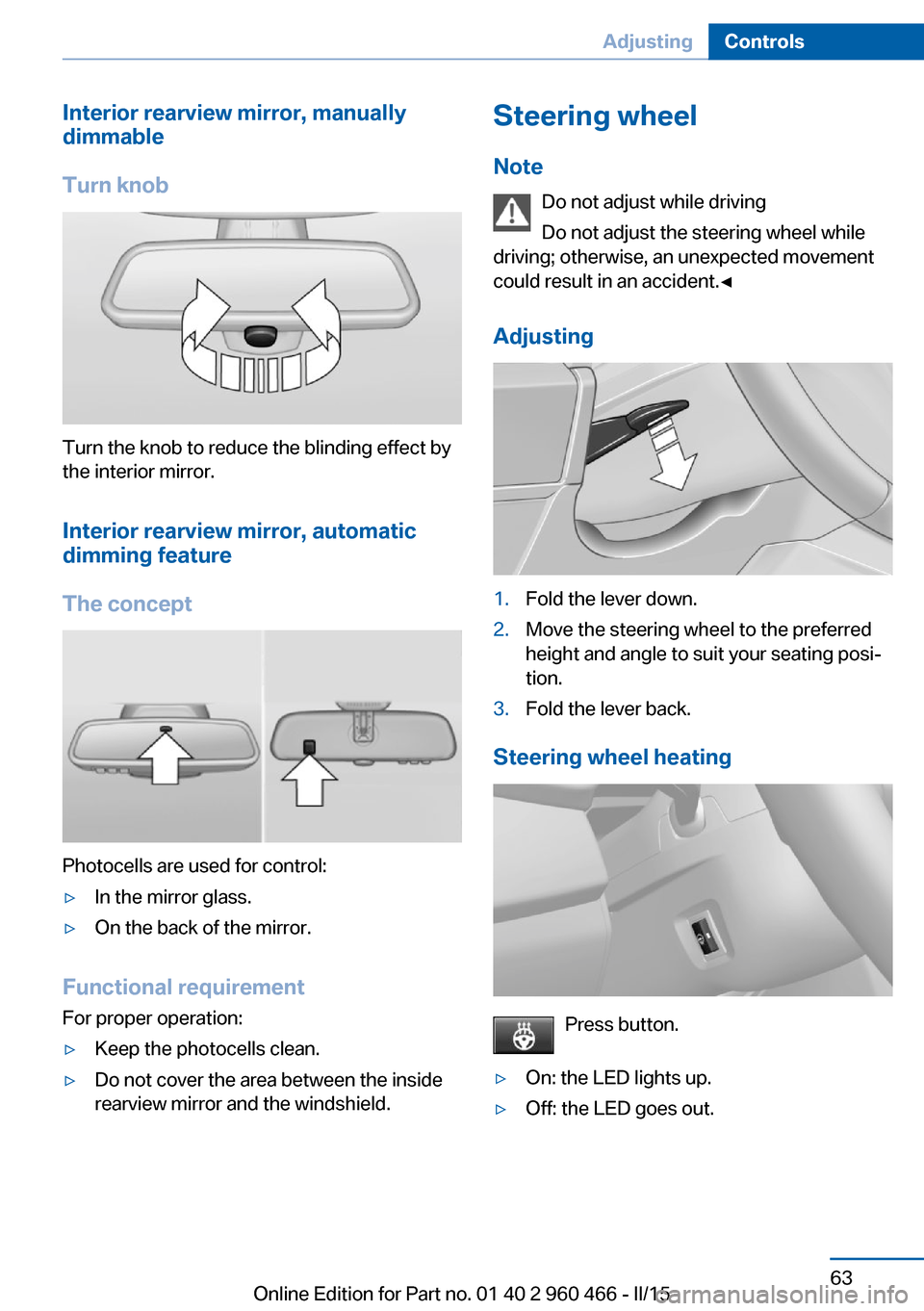
Interior rearview mirror, manually
dimmable
Turn knob
Turn the knob to reduce the blinding effect by
the interior mirror.
Interior rearview mirror, automaticdimming feature
The concept
Photocells are used for control:
‚Ė∑In the mirror glass.‚Ė∑On the back of the mirror.
Functional requirement For proper operation:
‚Ė∑Keep the photocells clean.‚Ė∑Do not cover the area between the inside
rearview mirror and the windshield.Steering wheel
Note Do not adjust while driving
Do not adjust the steering wheel while
driving; otherwise, an unexpected movement
could result in an accident.‚óÄ
Adjusting1.Fold the lever down.2.Move the steering wheel to the preferred
height and angle to suit your seating posi‚Äź
tion.3.Fold the lever back.
Steering wheel heating
Press button.
‚Ė∑On: the LED lights up.‚Ė∑Off: the LED goes out.Seite 63AdjustingControls63
Online Edition for Part no. 01 40 2 960 466 - II/15
Page 74 of 251
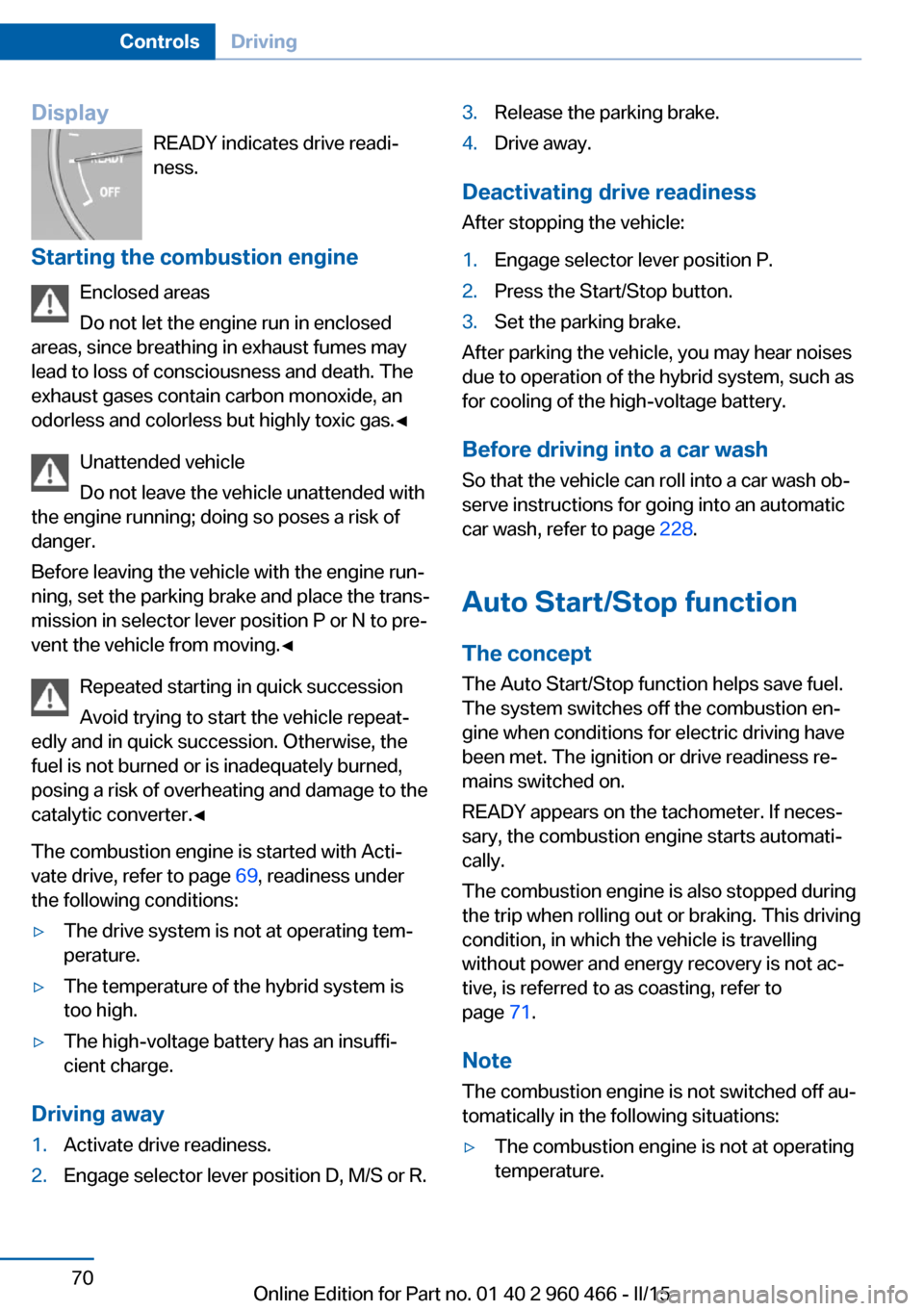
DisplayREADY indicates drive readi‚Äź
ness.
Starting the combustion engine Enclosed areas
Do not let the engine run in enclosed
areas, since breathing in exhaust fumes may
lead to loss of consciousness and death. The
exhaust gases contain carbon monoxide, an
odorless and colorless but highly toxic gas.‚óÄ
Unattended vehicle
Do not leave the vehicle unattended with
the engine running; doing so poses a risk of
danger.
Before leaving the vehicle with the engine run‚Äź
ning, set the parking brake and place the trans‚Äź
mission in selector lever position P or N to pre‚Äź
vent the vehicle from moving.‚óÄ
Repeated starting in quick succession
Avoid trying to start the vehicle repeat‚Äź
edly and in quick succession. Otherwise, the
fuel is not burned or is inadequately burned,
posing a risk of overheating and damage to the
catalytic converter.‚óÄ
The combustion engine is started with Acti‚Äź
vate drive, refer to page 69, readiness under
the following conditions:‚Ė∑The drive system is not at operating tem‚Äź
perature.‚Ė∑The temperature of the hybrid system is
too high.‚Ė∑The high-voltage battery has an insuffi‚Äź
cient charge.
Driving away
1.Activate drive readiness.2.Engage selector lever position D, M/S or R.3.Release the parking brake.4.Drive away.
Deactivating drive readiness
After stopping the vehicle:
1.Engage selector lever position P.2.Press the Start/Stop button.3.Set the parking brake.
After parking the vehicle, you may hear noises
due to operation of the hybrid system, such as
for cooling of the high-voltage battery.
Before driving into a car wash So that the vehicle can roll into a car wash ob‚Äź
serve instructions for going into an automatic
car wash, refer to page 228.
Auto Start/Stop function
The concept The Auto Start/Stop function helps save fuel.
The system switches off the combustion en‚Äź
gine when conditions for electric driving have
been met. The ignition or drive readiness re‚Äź
mains switched on.
READY appears on the tachometer. If neces‚Äź
sary, the combustion engine starts automati‚Äź
cally.
The combustion engine is also stopped during
the trip when rolling out or braking. This driving
condition, in which the vehicle is travelling
without power and energy recovery is not ac‚Äź
tive, is referred to as coasting, refer to
page 71.
Note The combustion engine is not switched off au‚Äź
tomatically in the following situations:
‚Ė∑The combustion engine is not at operating
temperature.Seite 70ControlsDriving70
Online Edition for Part no. 01 40 2 960 466 - II/15
Page 75 of 251
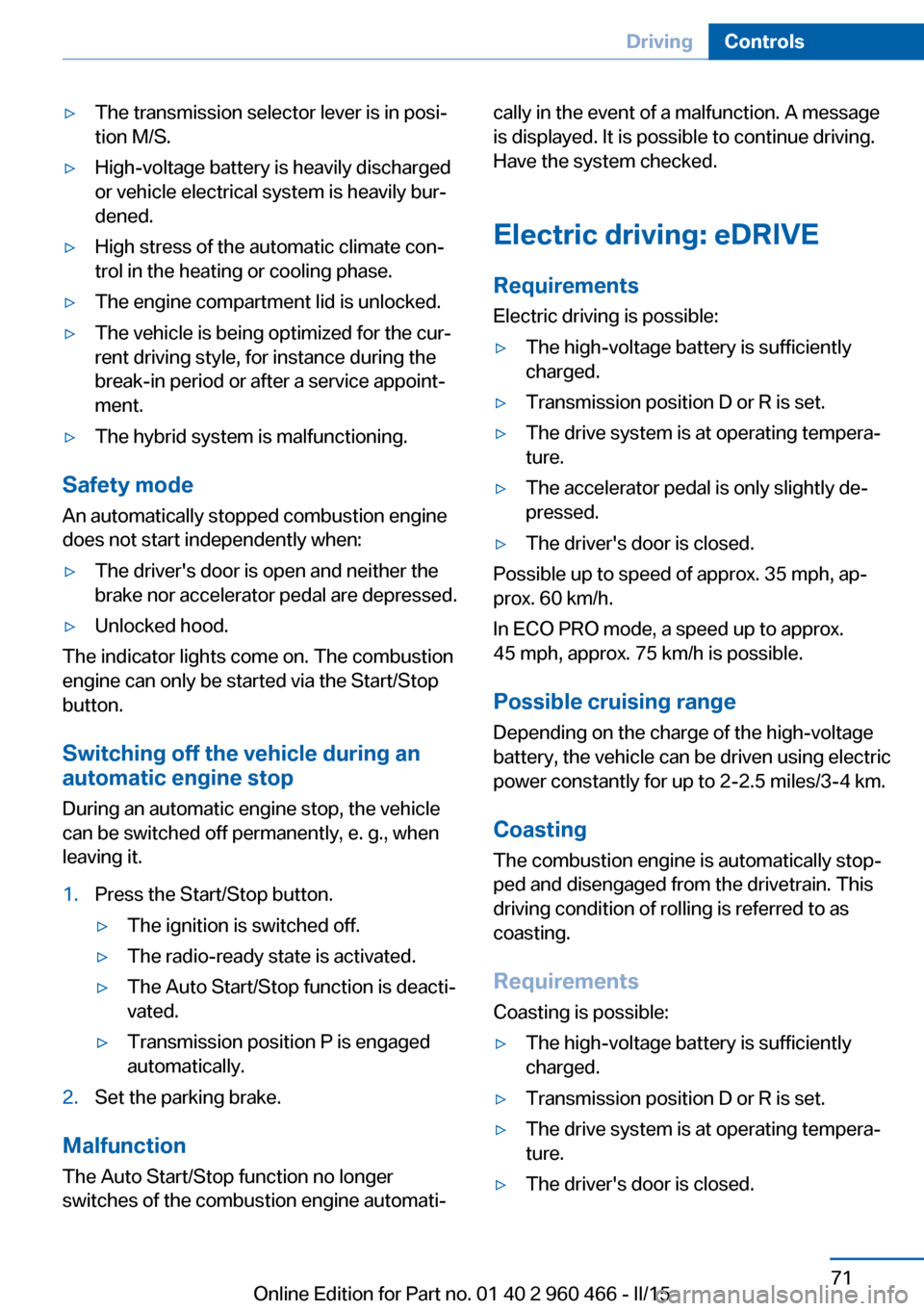
‚Ė∑The transmission selector lever is in posi‚Äź
tion M/S.‚Ė∑High-voltage battery is heavily discharged
or vehicle electrical system is heavily bur‚Äź
dened.‚Ė∑High stress of the automatic climate con‚Äź
trol in the heating or cooling phase.‚Ė∑The engine compartment lid is unlocked.‚Ė∑The vehicle is being optimized for the cur‚Äź
rent driving style, for instance during the
break-in period or after a service appoint‚Äź
ment.‚Ė∑The hybrid system is malfunctioning.
Safety mode
An automatically stopped combustion engine
does not start independently when:
‚Ė∑The driver's door is open and neither the
brake nor accelerator pedal are depressed.‚Ė∑Unlocked hood.
The indicator lights come on. The combustion
engine can only be started via the Start/Stop
button.
Switching off the vehicle during an automatic engine stop
During an automatic engine stop, the vehicle
can be switched off permanently, e. g., when
leaving it.
1.Press the Start/Stop button.‚Ė∑The ignition is switched off.‚Ė∑The radio-ready state is activated.‚Ė∑The Auto Start/Stop function is deacti‚Äź
vated.‚Ė∑Transmission position P is engaged
automatically.2.Set the parking brake.
Malfunction
The Auto Start/Stop function no longer
switches of the combustion engine automati‚Äź
cally in the event of a malfunction. A message is displayed. It is possible to continue driving.
Have the system checked.
Electric driving: eDRIVE
Requirements Electric driving is possible:‚Ė∑The high-voltage battery is sufficiently
charged.‚Ė∑Transmission position D or R is set.‚Ė∑The drive system is at operating tempera‚Äź
ture.‚Ė∑The accelerator pedal is only slightly de‚Äź
pressed.‚Ė∑The driver's door is closed.
Possible up to speed of approx. 35 mph, ap‚Äź
prox. 60 km/h.
In ECO PRO mode, a speed up to approx.
45 mph, approx. 75 km/h is possible.
Possible cruising range
Depending on the charge of the high-voltage
battery, the vehicle can be driven using electric
power constantly for up to 2-2.5 miles/3-4 km.
CoastingThe combustion engine is automatically stop‚Äź
ped and disengaged from the drivetrain. This
driving condition of rolling is referred to as
coasting.
Requirements Coasting is possible:
‚Ė∑The high-voltage battery is sufficiently
charged.‚Ė∑Transmission position D or R is set.‚Ė∑The drive system is at operating tempera‚Äź
ture.‚Ė∑The driver's door is closed.Seite 71DrivingControls71
Online Edition for Part no. 01 40 2 960 466 - II/15
Page 155 of 251

Climate controlVehicle features and options
This chapter describes all standard, country-
specific and optional features offered with the
series. It also describes features that are not
necessarily available in your car, e. g., due tothe selected options or country versions. This
also applies to safety-related functions and
systems. The respectively applicable country
provisions must be observed when using the
respective features and systems.
Automatic climate control with enhanced features
1Seat heating, left‚Äā‚ÄÖ 572Temperature, left3AUTO program4Display5Maximum cooling6Temperature, right7Seat heating, right‚Äā‚ÄÖ 578Cooling function9Automatic recirculated-air control/recircu‚Äź
lated-air mode10Air distribution, right11Air flow, AUTO intensity12Air distribution, left13Rear window defroster14Interior temperature sensor ‚ÄĒ always keep
clear15Defrosts windows and removes condensa‚Äź
tionSeite 151Climate controlControls151
Online Edition for Part no. 01 40 2 960 466 - II/15
Page 156 of 251
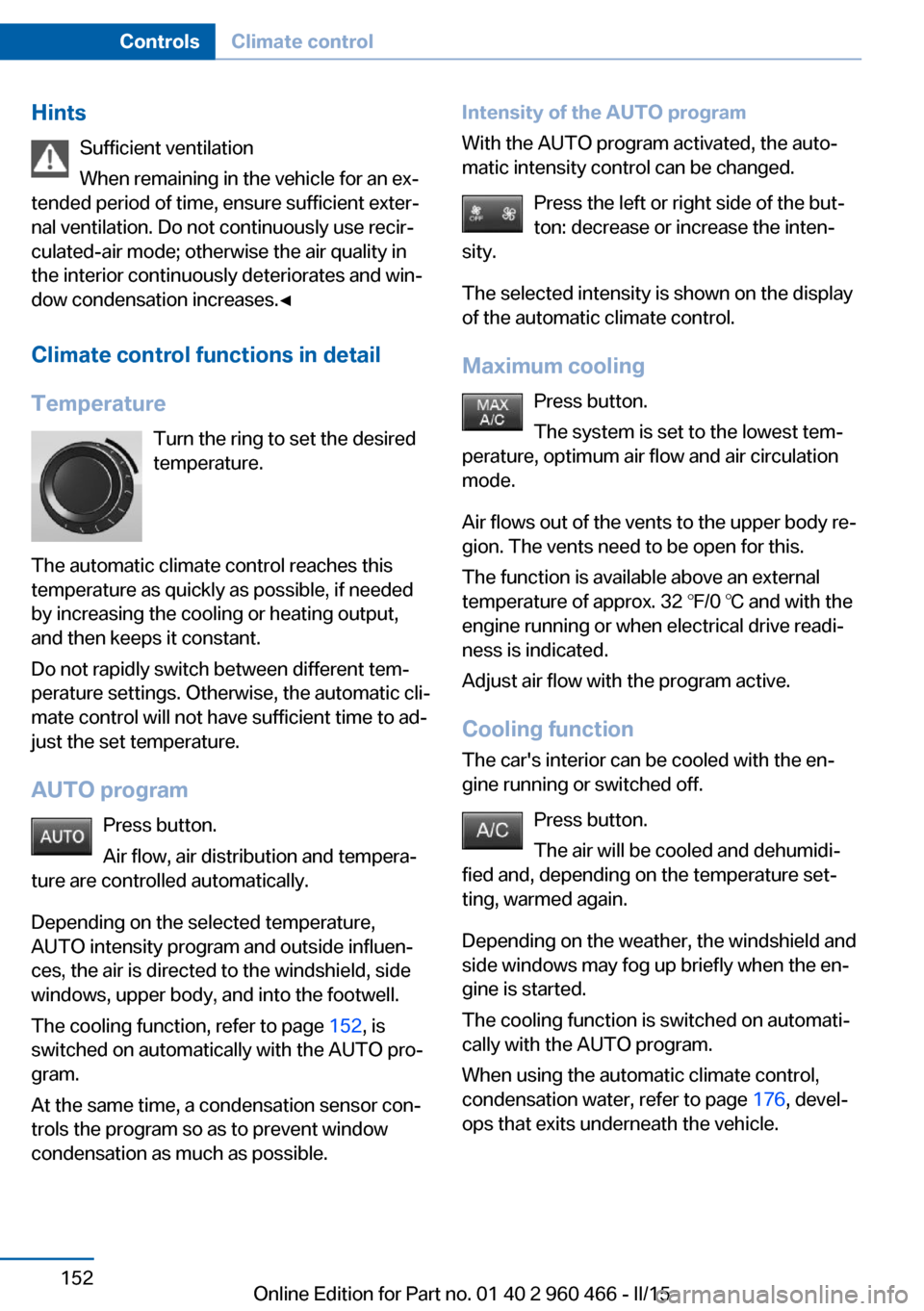
HintsSufficient ventilation
When remaining in the vehicle for an ex‚Äź
tended period of time, ensure sufficient exter‚Äź
nal ventilation. Do not continuously use recir‚Äź
culated-air mode; otherwise the air quality in
the interior continuously deteriorates and win‚Äź
dow condensation increases.‚óÄ
Climate control functions in detail
Temperature Turn the ring to set the desired
temperature.
The automatic climate control reaches this
temperature as quickly as possible, if needed
by increasing the cooling or heating output,
and then keeps it constant.
Do not rapidly switch between different tem‚Äź
perature settings. Otherwise, the automatic cli‚Äź
mate control will not have sufficient time to ad‚Äź
just the set temperature.
AUTO program Press button.
Air flow, air distribution and tempera‚Äź
ture are controlled automatically.
Depending on the selected temperature,
AUTO intensity program and outside influen‚Äź ces, the air is directed to the windshield, side
windows, upper body, and into the footwell.
The cooling function, refer to page 152, is
switched on automatically with the AUTO pro‚Äź
gram.
At the same time, a condensation sensor con‚Äź
trols the program so as to prevent window
condensation as much as possible.Intensity of the AUTO program
With the AUTO program activated, the auto‚Äź
matic intensity control can be changed.
Press the left or right side of the but‚Äź
ton: decrease or increase the inten‚Äź
sity.
The selected intensity is shown on the display
of the automatic climate control.
Maximum cooling Press button.
The system is set to the lowest tem‚Äź
perature, optimum air flow and air circulation
mode.
Air flows out of the vents to the upper body re‚Äź
gion. The vents need to be open for this.
The function is available above an external
temperature of approx. 32 ‚ĄČ/0 ‚ĄÉ and with the
engine running or when electrical drive readi‚Äź ness is indicated.
Adjust air flow with the program active.
Cooling function
The car's interior can be cooled with the en‚Äź
gine running or switched off.
Press button.
The air will be cooled and dehumidi‚Äź
fied and, depending on the temperature set‚Äź
ting, warmed again.
Depending on the weather, the windshield and
side windows may fog up briefly when the en‚Äź
gine is started.
The cooling function is switched on automati‚Äź
cally with the AUTO program.
When using the automatic climate control,
condensation water, refer to page 176, devel‚Äź
ops that exits underneath the vehicle.Seite 152ControlsClimate control152
Online Edition for Part no. 01 40 2 960 466 - II/15
Page 158 of 251
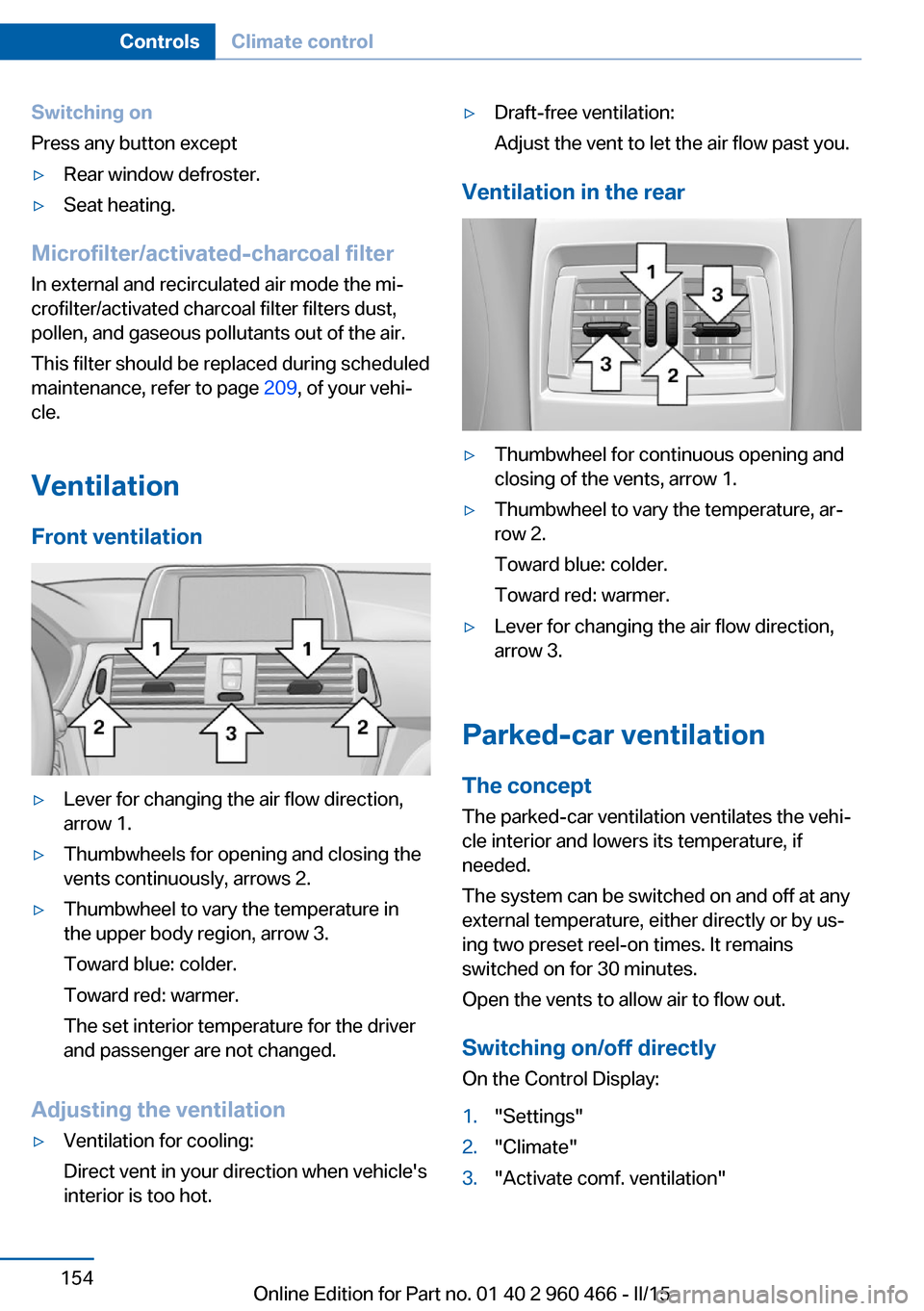
Switching on
Press any button except‚Ė∑Rear window defroster.‚Ė∑Seat heating.
Microfilter/activated-charcoal filter
In external and recirculated air mode the mi‚Äź
crofilter/activated charcoal filter filters dust,
pollen, and gaseous pollutants out of the air.
This filter should be replaced during scheduled
maintenance, refer to page 209, of your vehi‚Äź
cle.
Ventilation
Front ventilation
‚Ė∑Lever for changing the air flow direction,
arrow 1.‚Ė∑Thumbwheels for opening and closing the
vents continuously, arrows 2.‚Ė∑Thumbwheel to vary the temperature in
the upper body region, arrow 3.
Toward blue: colder.
Toward red: warmer.
The set interior temperature for the driver
and passenger are not changed.
Adjusting the ventilation
‚Ė∑Ventilation for cooling:
Direct vent in your direction when vehicle's
interior is too hot.‚Ė∑Draft-free ventilation:
Adjust the vent to let the air flow past you.
Ventilation in the rear
‚Ė∑Thumbwheel for continuous opening and
closing of the vents, arrow 1.‚Ė∑Thumbwheel to vary the temperature, ar‚Äź
row 2.
Toward blue: colder.
Toward red: warmer.‚Ė∑Lever for changing the air flow direction,
arrow 3.
Parked-car ventilation
The concept The parked-car ventilation ventilates the vehi‚Äź
cle interior and lowers its temperature, if
needed.
The system can be switched on and off at any
external temperature, either directly or by us‚Äź
ing two preset reel-on times. It remains
switched on for 30 minutes.
Open the vents to allow air to flow out.
Switching on/off directly
On the Control Display:
1."Settings"2."Climate"3."Activate comf. ventilation"Seite 154ControlsClimate control154
Online Edition for Part no. 01 40 2 960 466 - II/15
Page 181 of 251
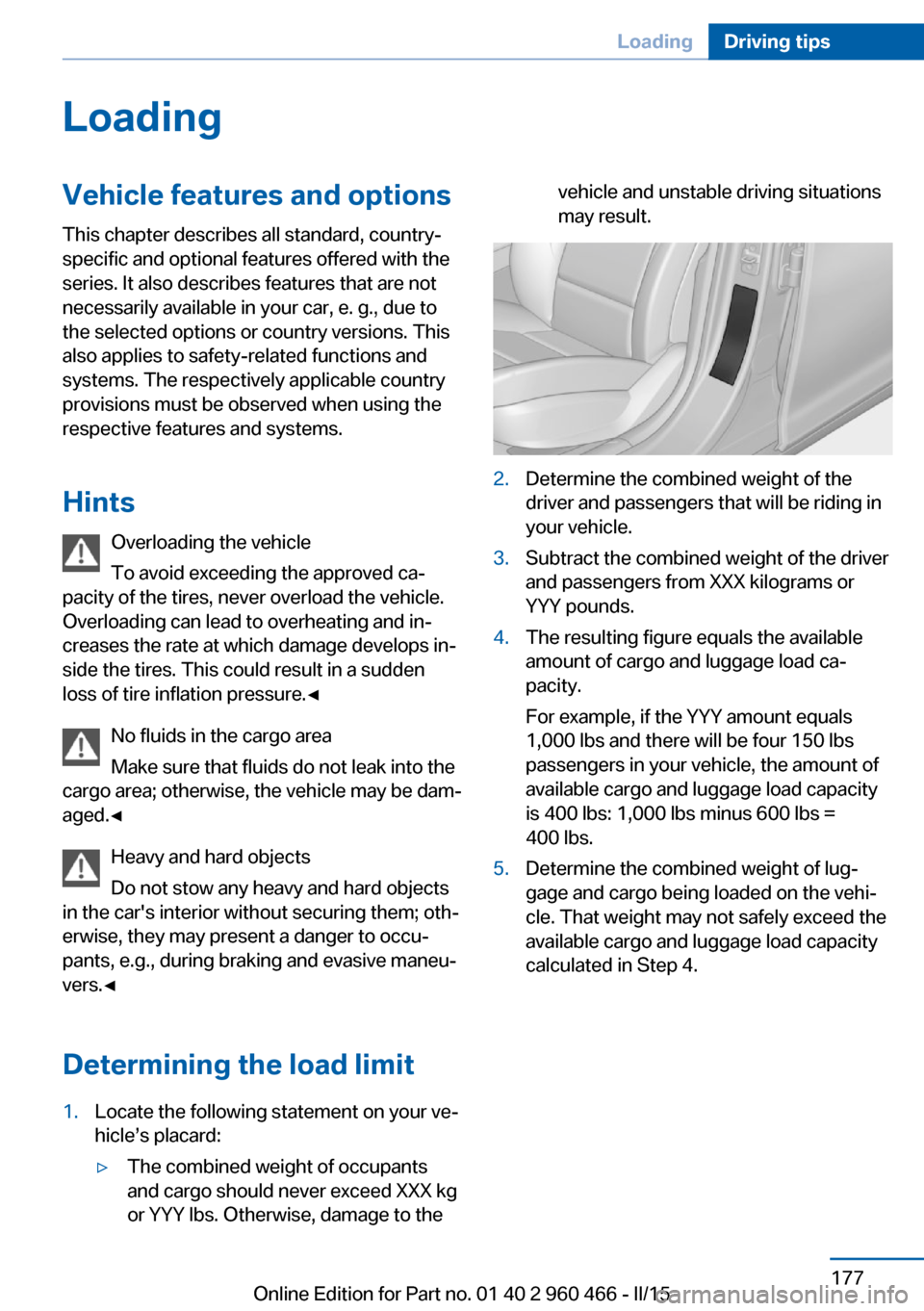
LoadingVehicle features and options
This chapter describes all standard, country-
specific and optional features offered with the
series. It also describes features that are not
necessarily available in your car, e. g., due to
the selected options or country versions. This
also applies to safety-related functions and
systems. The respectively applicable country
provisions must be observed when using the
respective features and systems.
Hints Overloading the vehicle
To avoid exceeding the approved ca‚Äź
pacity of the tires, never overload the vehicle.
Overloading can lead to overheating and in‚Äź
creases the rate at which damage develops in‚Äź
side the tires. This could result in a sudden
loss of tire inflation pressure.‚óÄ
No fluids in the cargo area
Make sure that fluids do not leak into the
cargo area; otherwise, the vehicle may be dam‚Äź
aged.‚óÄ
Heavy and hard objects
Do not stow any heavy and hard objects
in the car's interior without securing them; oth‚Äź
erwise, they may present a danger to occu‚Äź
pants, e.g., during braking and evasive maneu‚Äź
vers.‚óÄ
Determining the load limit1.Locate the following statement on your ve‚Äź
hicle‚Äôs placard:‚Ė∑The combined weight of occupants
and cargo should never exceed XXX kg
or YYY lbs. Otherwise, damage to thevehicle and unstable driving situations
may result.2.Determine the combined weight of the
driver and passengers that will be riding in
your vehicle.3.Subtract the combined weight of the driver
and passengers from XXX kilograms or
YYY pounds.4.The resulting figure equals the available
amount of cargo and luggage load ca‚Äź
pacity.
For example, if the YYY amount equals
1,000 lbs and there will be four 150 lbs
passengers in your vehicle, the amount of
available cargo and luggage load capacity
is 400 lbs: 1,000 lbs minus 600 lbs =
400 lbs.5.Determine the combined weight of lug‚Äź
gage and cargo being loaded on the vehi‚Äź
cle. That weight may not safely exceed the
available cargo and luggage load capacity
calculated in Step 4.Seite 177LoadingDriving tips177
Online Edition for Part no. 01 40 2 960 466 - II/15